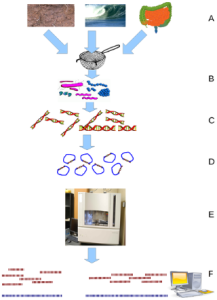Metagenomics studies the genetic material of uncultured microorganisms (bacteria, virus and archaea). These microorganisms are obtained directly from biological samples, including human, animal, plant and environmental samples even food products. Although metagenomics is a new research field, we have seen the rapid growth of computational methods and the publication of numerous articles in this field in recent years. One of the main goals of metagenomics is to determine the role of these microorganisms. Recently, new sequencing technologies and significant reduction in sequencing costs have greatly contributed to the development of this approach. One of the main applications of metagenomics is in the field of health and disease. Today, using this science, the origin of many common human diseases, including gastrointestinal and metabolic diseases, has been identified. Scientists have also used this knowledge to develop microbial-based therapies, such as using the food product fortified with beneficial microbes.
Different stages of a metagenomics study:
- A) Sampling from habitat
- B) Filtering particles, typically by size
- C) DNA extraction and analysis
- D) Cloning and library
- E) Sequencing of clones
- F) Delete low quality sequences
- ۱) Saving files in FASTQ format
- ۲) Performing bioinformatics analyzes and determining the abundance and diversity of the microbial community.
Figure1. Steps of preparation and study of different samples using metagenomics. https://journals.plos.org/ploscompbiol/article?id=10.1371/journal.pcbi.1000667
Metagenomics / Statistical analysis:
- Principal component analysis (PCA)
- α and β diversity
- Principal Coordinates Analysis (PCoA)
- Differential abundance analysis
Prepared by: Parvin Zarei
Reference
A Primer on Metagenomics. https://doi.org/10.1371/journal.pcbi.1000667


